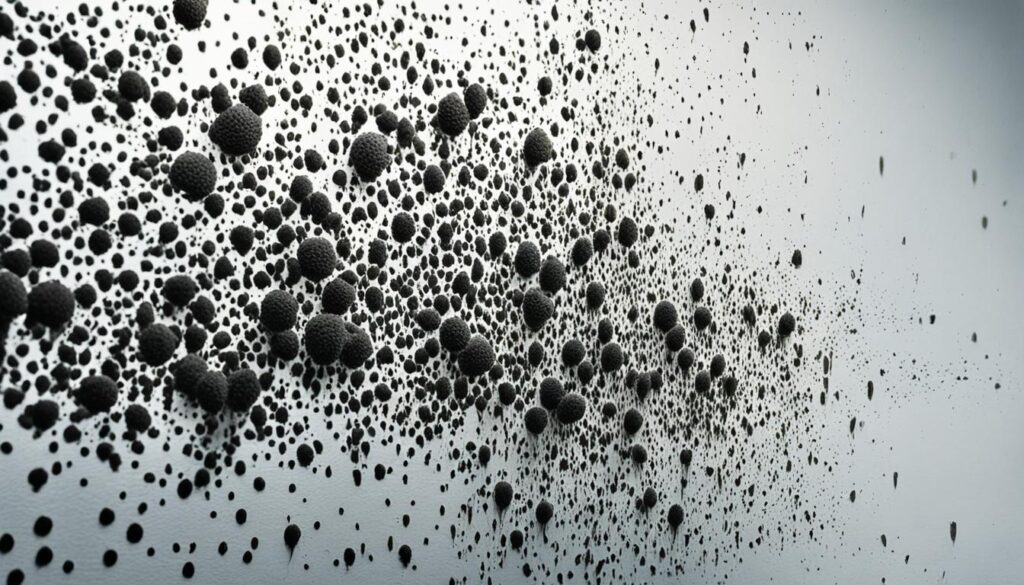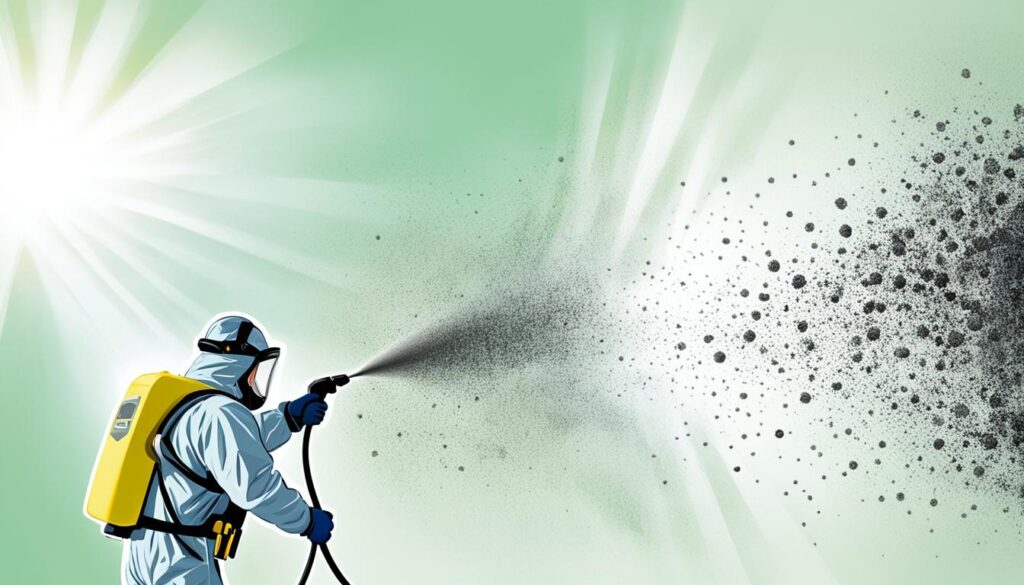
Eradicate Black Mold: Safe Removal Guide
Welcome to our comprehensive guide on how to effectively get rid of black mold in your home. Black mold, also known as Stachybotrys chartarum, can be a persistent and harmful presence in any household. Not only can it cause structural damage to your property, but it can also pose serious health risks to you and your family.
Black mold thrives in damp and humid environments, such as bathrooms, basements, and areas affected by water leaks or flooding. Its dark appearance and musty odor make it easy to identify. If left untreated, black mold can spread rapidly, causing further damage and compromising air quality.
In this safe removal guide, we will walk you through the step-by-step process of eliminating black mold from your home. Our focus is on using safe and effective techniques to ensure the protection of both your home and your health.
Key Takeaways:
- Black mold can cause structural damage and pose health risks.
- It thrives in damp and humid environments.
- Identify the affected areas and take appropriate safety precautions.
- Use safe and effective techniques for black mold removal.
- Prevent future mold growth by addressing moisture issues in your home.
Understanding Black Mold and Its Dangers
Before diving into the removal process, it’s crucial to have a clear understanding of black mold and the potential dangers it poses to both your property and your health. Black mold, scientifically known as Stachybotrys chartarum, is a type of fungus that commonly grows in areas with high moisture levels and organic materials.
Black mold thrives in damp and humid environments, such as bathrooms, basements, and areas affected by water damage. It can be identified by its dark green or black color and a slimy texture. This type of mold releases spores into the air, which can trigger various health issues when inhaled or come into contact with the skin.
Did You Know? Black mold can grow on a wide range of surfaces, including wood, drywall, carpet, and fabrics. Its rapid growth and ability to spread quickly make it a serious concern for homeowners.
Exposure to black mold can lead to a variety of health problems, especially for individuals with weakened immune systems or pre-existing respiratory conditions. The presence of black mold in your living environment can cause symptoms such as coughing, sneezing, sore throat, nasal congestion, respiratory infections, and allergic reactions.
Furthermore, some studies suggest a potential link between black mold exposure and more severe health issues, including chronic sinus infections, asthma attacks, bronchitis, and even neurological problems. It is crucial to address black mold growth promptly to minimize these risks and protect your well-being.
Common Health Risks Associated with Black Mold Exposure:
- Respiratory issues, including coughing, wheezing, and shortness of breath
- Allergic reactions, such as skin rashes, red eyes, and runny nose
- Headaches and migraines
- Fatigue and weakness
- Difficulty concentrating and memory problems
- Chronic sinusitis and nasal congestion
To visually understand the growth and spread of black mold, refer to the following image:

Now that we have explored the nature of black mold and its potential dangers, we can proceed to the next section, which focuses on safe and effective techniques for removing black mold from your home.
Safe and Effective Techniques for Black Mold Removal
When it comes to dealing with black mold in your home, it’s important to prioritize safety and employ effective techniques for its removal. Taking the right approach will not only help eradicate the mold but also ensure the well-being of your family and the integrity of your property. In this section, we will guide you through a step-by-step process, providing you with the necessary knowledge and tools to safely and effectively remove black mold.
Identifying the Affected Areas
Before beginning the removal process, it’s essential to identify the areas affected by black mold. Inspect your home thoroughly, paying close attention to areas with excess moisture, such as bathrooms, basements, and laundry rooms. Look for visible signs of mold growth, including dark spots, discoloration, or a musty odor. Note down all the areas that require attention and make a plan to tackle them systematically.
Choosing the Right Cleaning Solutions
Once you have identified the affected areas, it’s time to select the appropriate cleaning solutions for each surface. Different materials require different treatments, and using the wrong cleaning solution can cause further damage or be ineffective. Refer to the table below for a comprehensive guide on recommended cleaning solutions for various surfaces:
| Surface | Cleaning Solution |
|---|---|
| Tiles and Grout | Bleach solution (1 cup bleach per gallon of water) |
| Non-Porous Surfaces (e.g., glass, plastic, metal) | Detergent and water solution |
| Wood Surfaces | Vinegar solution (1 part vinegar, 1 part water) |
| Carpet and Upholstery | Carpet cleaner or professional mold removal service |
Using Protective Gear
Prioritize your safety while removing black mold by wearing appropriate protective gear. The table below outlines the essential gear you should have to ensure adequate protection:
- N95 respirator mask: Protects against mold spores inhalation.
- Gloves: Prevents direct contact with mold and cleaning solutions.
- Goggles: Shields the eyes from mold spores and cleaning chemicals.
- Disposable Coveralls: Keeps your body protected from mold and cleaning solution exposure.
Safe Removal Process
Now that you have identified the affected areas, chosen the appropriate cleaning solutions, and have your protective gear ready, it’s time to start the safe removal process. Follow these steps:
- Begin by ventilating the area by opening windows and using fans.
- Seal off the affected area with plastic sheets to prevent cross-contamination.
- Carefully remove any loose or visible mold using disposable materials, such as paper towels or rags.
- Apply the chosen cleaning solution to the affected surfaces and scrub gently using a brush.
- Thoroughly rinse the area with clean water.
- Dry the area completely to prevent moisture and mold regrowth.
- Dispose of all used materials in a sealed bag and clean your protective gear.
Seeking Professional Assistance
If you encounter widespread or severe black mold infestation, or if you have underlying health conditions, it may be best to seek professional assistance. Professional mold remediation experts have the experience, knowledge, and equipment to handle extensive mold problems effectively and safely.

Conclusion
In conclusion, black mold is a serious issue that should not be taken lightly. It can have detrimental effects on both the structure of your home and your overall health. However, by following the safe removal guide provided in this article, you can effectively eliminate black mold and protect your home.
Remember to always prioritize safety when dealing with black mold. Wear appropriate protective gear, such as gloves and masks, to prevent inhalation or direct contact with the mold spores. Additionally, make sure to properly ventilate the area and dispose of contaminated materials in sealed bags.
If you find the black mold problem to be overwhelming or require professional assistance, don’t hesitate to reach out to Fix Mold Miami. Their team of experts specializes in mold assessment, prevention, and remediation, and they can provide you with the necessary support and solutions. Contact Fix Mold Miami at 305-465-6653 to ensure your home is mold-free and safe.




